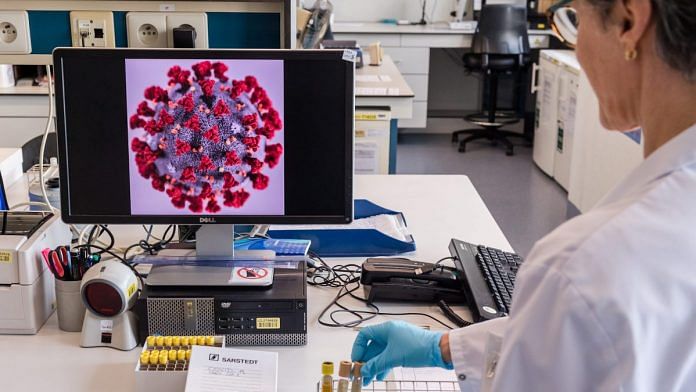New Delhi: Researchers at the University of Bristol have identified what makes the novel coronavirus highly infectious and how it is able to infect human cells.
Published on 20 October in Science, the study found that neuropilin-1 — a transmembrane protein — serves as a host factor for SARS-CoV-2 infection and could potentially make for a therapeutic target for Covid-19.
By identifying the protein used by the virus to infect human cells, this study also defined a “potential target for antiviral intervention”.
SARS-CoV-2, which is the causative agent of Covid-19, causes common cold like symptoms and is highly infectious and transmissible. It can also infect the brain and the heart, apart from the respiratory system.
To enter the human cells, the SARS-CoV-2 attaches itself onto the cells that line the respiratory or the intestinal tract.
The virus is able to attach itself and invade the human cells with the help of a viral protein, called spike protein. The presence of these proteins gives the coronavirus spike-shaped protrusion on their surface. After invading the human cells, the SARS-CoV-2 replicates into multiple viruses.
The virus identifies neuropilin-1 on the surface of human cells, which facilitates the virus to infect the cell. Originally, the neuropilins were identified as ‘adhesion molecules‘ in the nervous system. They are responsible for facilitating cellular behaviours like cell adhesion, survival, repulsion and attraction.
Also read: Johnson & Johnson halts Covid vaccine trial due to unexplained illness in one participant
What the researchers say
The latest study was conducted in Bristol’s Faculty of Life Sciences.
Professor Peter Cullen from the School of Biochemistry, Dr Yohei Yamauch, associate professor and virologist from the School of Cellular and Molecular Medicine, and Dr Boris Simoneeti, a senior researcher in the Cullen Lab, explained how they went about the experiment.
“In looking at the sequence of the SARS-CoV-2 spike protein we were struck by the presence of a small sequence of amino acids that appeared to mimic a protein sequence found in human proteins which interacts with neuropilin-1. This led us to propose a simple hypothesis: could the Spike protein of SARS-CoV-2 associate with neuropilin-1 to aid viral infection of human cells?” the researchers said in their report.
“Excitingly, in applying a range of structural and biochemical approaches we have been able to establish that the Spike protein of SARS-CoV-2 does indeed bind to neuropilin-1,” they added.
The researchers were also able to establish that by using monoclonal antibodies, which are lab-created proteins similar to naturally occurring antibodies, they were successful in reducing SARS-CoV-2’s ability to infect human cells. “This serves to highlight the potential therapeutic value of our discovery in the fight against COVID-19,” the researchers added.
Host factor an ‘ambiguous term’
Noted virologist Shahid Jameel told ThePrint that this study looked at which proteins on human cells are important for the virus to infect the cells.
“Not all viruses infect all cells in the body, there has to be some specificity. For that, different viruses bind to different proteins on the surface of cells and once that docking takes place the virus enters the cell,” he said.
“A major protein that the SARS-CoV-2 uses to dock on cells is called ACE2, which acts as a receptor… This study has now found another protein on the surface of cells called neuropilin. They suggest that the virus could enter cells by first binding to this protein,” Jameel added.
He highlighted that the study was not identifying neuropilin as a receptor but a host factor.
“They use the term host factor which is very ambiguous. When a virus binds to a bonafide receptor, this binding causes changes in both the virus and the receptor which leads to changes within the cell… However, this study hasn’t proven conclusively that neuropilin is a receptor,” he added.
Also read: Coronavirus could stay for weeks on currency notes, touchscreens, Australian study finds






